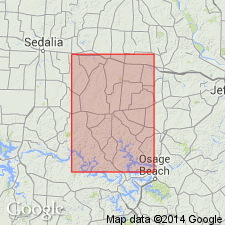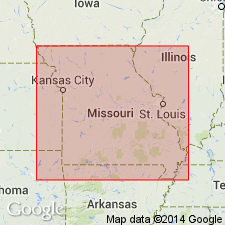
- Usage in publication:
-
- Bolin Creek sandstone member
- Modifications:
-
- Original reference
- Dominant lithology:
-
- Sandstone
- AAPG geologic province:
-
- Ozark uplift
Summary:
Pg. 50. Bolin Creek sandstone member of St. Elizabeth formation. Heavy deposits of sandstone, 1. to 50 feet thick, occurring as massive beds and as a number of thinner beds in uninterrupted succession in St. Elizabeth [Roubidoux formation to south of Osage River, in Miller County, central Missouri]. Age is Early Ordovician (Beekmantown).
Named from exposures in Bolin Creek, Miller Co., central MO. Extends into Morgan Co.
Source: US geologic names lexicon (USGS Bull. 896, p. 228).

- Usage in publication:
-
- Bolin sandstone member
- Modifications:
-
- Revised
- Areal extent
- AAPG geologic province:
-
- Forest City basin
- Ozark uplift
Summary:
Described Roubidoux formation of Morgan County, central Missouri, as consisting of (descending): (1) "Cotton rock" (fine-grained limestone); (2) Bolin sandstone member (persistent, consisting of 10 feet of gray and reddish sand, 8 to 15 feet of limestone and chert, and 10 feet of gray and reddish sand); (3) cherty magnesium limestone and chert; (4) sandstone in some places, heavy-bedded brecciated chert in other places. [Age is Early Ordovician (Beekmantown).]
Source: US geologic names lexicon (USGS Bull. 896, p. 228).

- Usage in publication:
-
- Bolin sandstone [member]
- Modifications:
-
- Not used
- AAPG geologic province:
-
- Ozark uplift
Summary:
Ball and Smith (1903, p. 50, 61) applied the term "Bolin Creek sandstone member" to the prominent sandstones within their "St. Elizabeth formation", which is essentially the Roubidoux formation of present nomenclature. Later it was sometimes shortened to "Bolin sandstone". It was named for exposures on Bolin Creek, Miller County, Missouri. Bolin Creek sandstone member of St. Elizabeth formation (Ball and Smith, 1903) = Roubidoux formation (part).
Source: Publication.
For more information, please contact Nancy Stamm, Geologic Names Committee Secretary.
Asterisk (*) indicates published by U.S. Geological Survey authors.
"No current usage" (†) implies that a name has been abandoned or has fallen into disuse. Former usage and, if known, replacement name given in parentheses ( ).
Slash (/) indicates name conflicts with nomenclatural guidelines (CSN, 1933; ACSN, 1961, 1970; NACSN, 1983, 2005, 2021). May be explained within brackets ([ ]).

